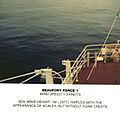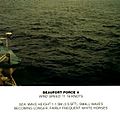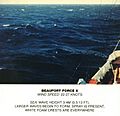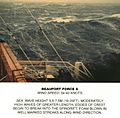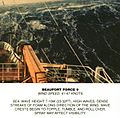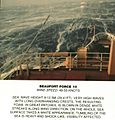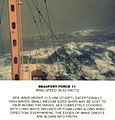Beaufort scale facts for kids
The Beaufort scale is a way to measure how fast the wind is blowing. It's based on what you can see, like how the sea looks or how trees are moving, rather than using special tools. It's the most common system used today to describe wind speed. The scale was created in 1805 by Francis Beaufort, an officer in the Royal Navy. It was first officially used on the ship HMS Beagle.
The scale has twelve main levels, from 0 (no wind) up to 12 (hurricane-force wind). From 1946 to 1970, there were also levels 13 to 17, all called Hurricane. These extra levels were only used in special situations and are no longer used around the world. However, China and Taiwan still use them because they often experience very strong storms called typhoons.
The heights of the waves mentioned in the scale are for the open ocean, far from the shore.
Understanding the Beaufort Scale
| Beaufort number | Wind speed | Description | Wave height | What the sea looks like | What it looks like on land | Sea state photo | ||||
|---|---|---|---|---|---|---|---|---|---|---|
| km/h | mph | kts | m/s | m | ft | |||||
| 0 | <1 | <1 | <1 | <0.3 | Calm | 0 | 0 | The sea is flat and still. | Smoke rises straight up. |  |
| 1 | 1-5 | 1-3 | 1-3 | 0.3-1.5 | Light air | 0.1 | 0.33 | Small ripples appear, but no whitecaps. | You can see wind in smoke. |  |
| 2 | 6-11 | 3-7 | 4-6 | 1.5-3.3 | Light breeze | 0.2 | 0.66 | Small waves form, looking glassy. | You can feel wind on your skin. Leaves rustle. |  |
| 3 | 12-19 | 8-12 | 7-10 | 3.3-5.5 | Gentle breeze | 0.6 | 2 | Larger waves appear. Some whitecaps start to form. | Leaves and small twigs move all the time. |  |
| 4 | 20-28 | 13-17 | 11-16 | 5.5-8.0 | Moderate breeze | 1 | 3.3 | Small waves are common. | Dust and loose paper blow around. Small branches start to move. |  |
| 5 | 29-38 | 18-24 | 17-21 | 8.0-10.8 | Fresh breeze | 2 | 6.6 | Waves are moderate and longer. Some foam and spray appear. | Medium-sized branches move. Small trees begin to sway. |  |
| 6 | 39-49 | 25-30 | 22-27 | 10.8-13.9 | Strong breeze | 3 | 9.9 | Large waves with foam crests and some spray. | Large branches move. You can hear whistling in wires. It's hard to use an umbrella. |  |
| 7 | 50-61 | 31-38 | 28-33 | 13.9-17.2 | High wind, Moderate Gale, Near Gale | 4 | 13.1 | The sea heaps up, and foam streaks appear. | Whole trees move. It's hard to walk against the wind. |  |
| 8 | 62-74 | 39-46 | 34-40 | 17.2-20.7 | Fresh Gale | 5.5 | 18 | Waves are moderately high with breaking crests. Foam streaks are visible. | Twigs break off trees. Cars may swerve on the road. |  |
| 9 | 75-88 | 47-54 | 41-47 | 20.7-24.5 | Strong Gale | 7 | 23 | Waves are high with thick foam. Wave crests begin to roll over. Lots of spray. | Larger branches break off trees. Some small trees blow over. |  |
| 10 | 89-102 | 55-63 | 48-55 | 24.5-28.4 | Whole Gale/Storm | 9 | 29.5 | Waves are very high. Large patches of foam make the sea look white. Lots of spray reduces visibility. | Trees break or are pulled up. Roof shingles may peel off. |  |
| 11 | 103-117 | 64-72 | 56-63 | 28.4-32.6 | Violent storm | 11.5 | 37.7 | Waves are exceptionally high. Very large patches of foam cover the sea. Lots of spray makes it hard to see. | Widespread damage to plants. More damage to roofs. |  |
| 12 | ≥118 | ≥73 | ≥64 | ≥32.6 | Hurricane-force | ≥14 | ≥46 | Waves are huge. The sea is completely white with foam and spray. Air is full of spray, making it very hard to see. | Much damage to plants. Some windows break. Mobile homes and sheds may be damaged. Debris flies around. |  |
More Images of Sea States
Images for kids
See also
 In Spanish: Escala de Beaufort para niños
In Spanish: Escala de Beaufort para niños


